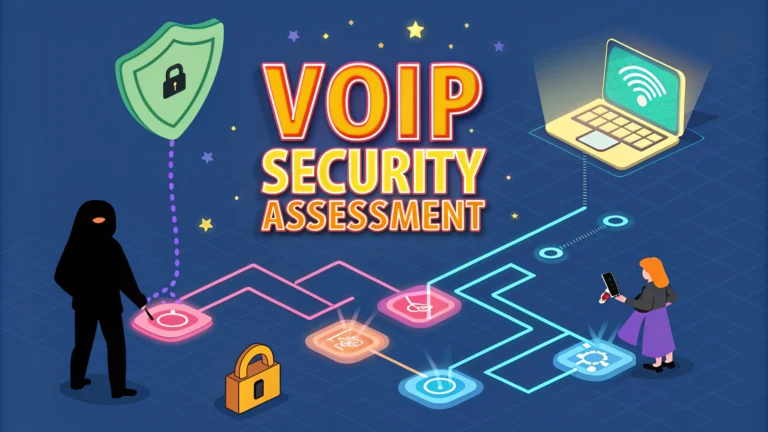VoIP systems have transformed business communications by offering cost-effective and feature-rich alternatives to traditional phone systems.
Security vulnerabilities in VoIP networks can lead to serious consequences including toll fraud, data theft, and service disruption.
A thorough VoIP security assessment helps identify and address these vulnerabilities before malicious actors can exploit them.
Key Components of VoIP Security Testing
- Network infrastructure analysis
- VoIP protocol testing (SIP, RTP, H.323)
- Authentication mechanism review
- Encryption implementation checks
- Access control verification
- Call quality monitoring
Common VoIP Security Threats
- Toll Fraud: Unauthorized use of VoIP services to make expensive calls
- Eavesdropping: Intercepting voice communications
- DoS Attacks: Overwhelming systems to disrupt service
- VLAN Hopping: Accessing restricted network segments
- Registration Hijacking: Taking over legitimate user accounts
Assessment Methodology
- Information gathering and network mapping
- Vulnerability scanning using specialized VoIP tools
- Manual testing of identified vulnerabilities
- Analysis of encryption and authentication methods
- Testing for common attack vectors
- Documentation of findings and recommendations
Essential Testing Tools
| Tool Name | Purpose |
|---|---|
| SIPVicious | SIP-based testing suite |
| Wireshark | Network protocol analysis |
| VoIPaudit | Security auditing |
| SIP Inspector | Protocol testing |
Security Best Practices
- Implement strong encryption (TLS/SRTP)
- Use robust authentication mechanisms
- Regularly update and patch systems
- Segment VoIP traffic from data networks
- Monitor call patterns for anomalies
- Maintain detailed logs of system activities
Mitigation Strategies
Network Level:
- Deploy Session Border Controllers (SBCs)
- Use VLANs to isolate voice traffic
- Implement intrusion detection systems
- Configure firewalls specifically for VoIP traffic
Application Level:
- Enable secure protocols (SIPS, SRTP)
- Implement account lockout policies
- Use strong password requirements
- Regular security patches and updates
Resources for Further Learning
- NIST SP 800-58: Security Considerations for VoIP Systems
- VOIP Security Alliance (VOIPSA) – www.voipsa.org
- Internet Engineering Task Force (IETF) VoIP Security Guidelines
Taking Action on Security Findings
Prioritize identified vulnerabilities based on risk level and potential impact to the organization.
Develop a remediation plan with clear timelines and responsibility assignments.
Schedule regular reassessments to ensure security measures remain effective.
Testing Documentation and Reporting
Comprehensive documentation of security testing results helps organizations track vulnerabilities and improvements over time.
- Detailed descriptions of discovered vulnerabilities
- Risk ratings for each finding
- Steps to reproduce issues
- Evidence and screenshots
- Technical and business impact analysis
Compliance and Regulatory Requirements
VoIP security assessments must consider relevant compliance standards:
- PCI DSS for payment card environments
- HIPAA for healthcare communications
- SOX for financial reporting systems
- GDPR for European data protection
Emerging VoIP Security Challenges
Cloud Integration
- Hybrid deployment security concerns
- Multi-tenant environment risks
- Cloud service provider dependencies
Mobile VoIP
- BYOD security implications
- Mobile endpoint protection
- Remote access vulnerabilities
Securing the Future of Voice Communications
Organizations must maintain a proactive approach to VoIP security through continuous monitoring, regular assessments, and adaptation to emerging threats.
Integration of artificial intelligence and machine learning can enhance threat detection and response capabilities.
Success in VoIP security requires commitment from both technical teams and management to implement and maintain robust security controls.
Essential Actions
- Establish ongoing security training programs
- Develop incident response procedures
- Maintain vendor relationships for support
- Keep security documentation current
- Plan for future technology adoption
FAQs
- What is a VoIP security assessment and why is it necessary?
A VoIP security assessment is a comprehensive evaluation of Voice over Internet Protocol systems to identify vulnerabilities, security gaps, and potential threats. It’s necessary to protect sensitive communications, prevent toll fraud, and ensure business continuity. - What are the common vulnerabilities found during VoIP penetration testing?
Common vulnerabilities include weak authentication mechanisms, unencrypted SIP traffic, exposed management interfaces, default credentials, toll fraud vulnerabilities, VLAN hopping opportunities, and DoS susceptibilities. - What tools are typically used in VoIP penetration testing?
Standard tools include SIPVicious suite, Wireshark, SIP Proxy, Ettercap, Nmap, Svmap, Svwar, Sipcrack, and specialized VoIP testing frameworks like VIPROY. - How does SIP enumeration work in VoIP testing?
SIP enumeration involves scanning and identifying SIP devices, extensions, and users on a network using tools like Svmap. This process helps identify potential attack vectors and vulnerable endpoints. - What security measures should be tested during a VoIP assessment?
Testing should cover encryption protocols (TLS/SRTP), authentication mechanisms, access controls, network segmentation, SIP trunking security, VoIP firewall rules, and QoS configurations. - How can man-in-the-middle attacks be detected during VoIP testing?
MITM attacks can be detected by monitoring network traffic for ARP spoofing, analyzing SIP message integrity, checking for unauthorized SIP proxies, and validating SSL/TLS certificates. - What are the signs of a potential toll fraud attack in VoIP systems?
Signs include unusual call patterns, unexpected international calls, calls during non-business hours, excessive call duration, and unauthorized SIP registration attempts. - How often should VoIP security assessments be conducted?
VoIP security assessments should be conducted at least annually, after major system changes, following security incidents, or when required by compliance regulations like PCI DSS or HIPAA. - What are the key areas to focus on when testing VoIP endpoint security?
Key areas include firmware vulnerabilities, password policies, physical security controls, encryption settings, access control mechanisms, and configuration hardening. - How can DoS attacks against VoIP systems be simulated safely?
DoS testing should be conducted in controlled environments using tools like SIPp or custom scripts, with proper monitoring and immediate rollback capabilities to prevent service disruption.







